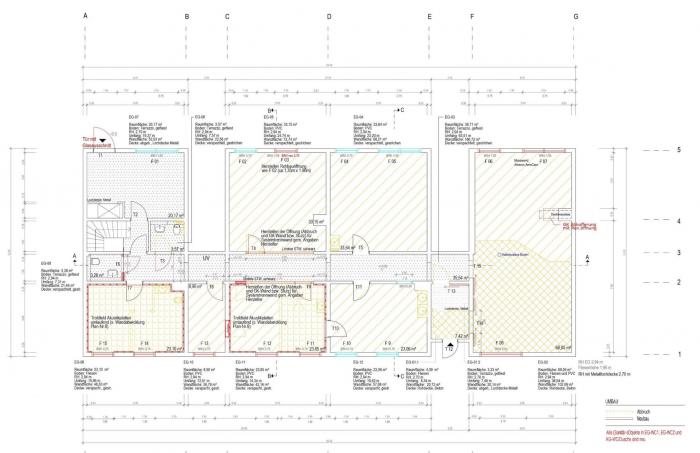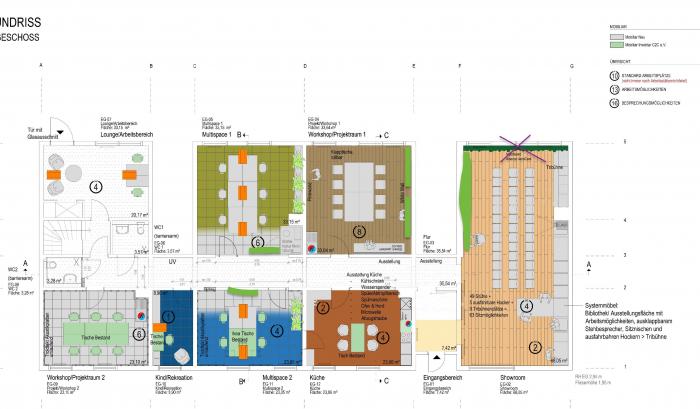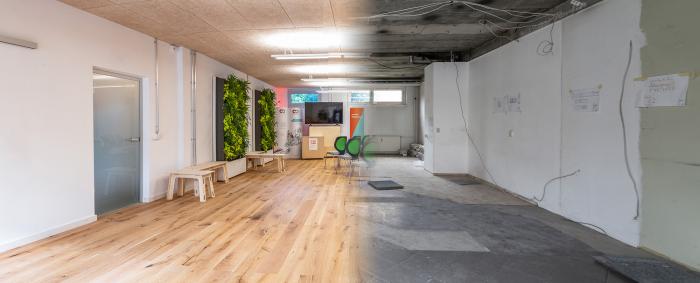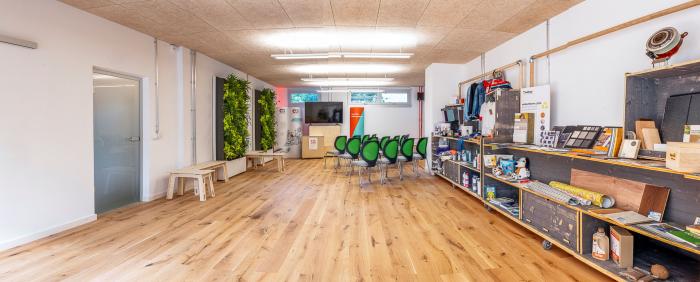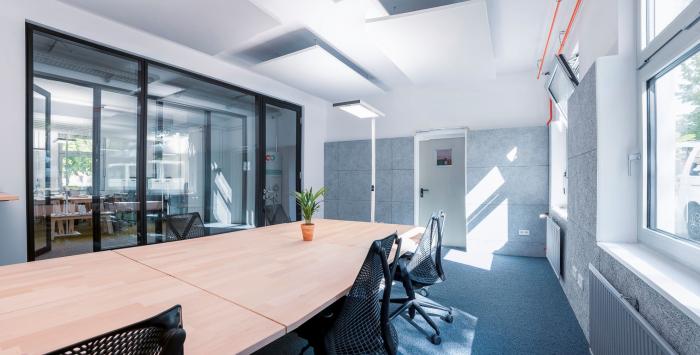I. SUMMARY INFORMATION
Project
267920
Status
Submitted
Award category
Buildings renovated in a spirit of circularity
You want to submit
NEW EUROPEAN BAUHAUS AWARDS : existing completed examples
Project title
C2C LAB
Full project title
C2C LAB - A Circular and Healthy Renovation in a Berlin Plattenbau
Description
The C2C LAB in Berlin is the world's first comprehensive refurbishment of an existing entity according to Cradle to Cradle criteria. In the most unlikely of buildings - a 1986 Berlin plattenbau - C2C NGO created a living lab, educational center and head office with only healthy and circular C2C materials. The LAB is modular and removable. lts interior consists only of recyclable or biodegradable materials. It brings changemakers together and accelerates the transition into a circular future.
Where was your project implemented in the EU?
Germany
Berlin
Landsberger Allee 99c
Berlin
10407
When was your project implemented?
Has your project benefited from EU programmes or funds?
No
Which programme(s) or fund(s)? Provide the name of the programme(s)/fund(s), the strand/action line as relevant and the year.
II. DESCRIPTION OF THE PROJECT
Please provide a summary of your project
In 2018, we were looking for a new head office in Berlin for our NGOs growing team. As there were no existing office spaces according to Cradle to Cradle criteria, but many unoccupied spaces in existing buildings, we decided to remodel one of them in the most unlikely setting for a healthy, fully removable, and circular space: A former pharmacy in a 1986 plattenbau by the traffic artery Landsberger Allee in the central district of Prenzlauer Berg. Together with approximaptely 50 partners we removed contaminated materials like PVC floorings from the 400 square meters big space, identified the remaining materials we could re-use, and worked out the concept for a holistic refurbishment using exclusively building and interior materials that comply with the C2C criteria material health, circularity, water stewardship, renewable energy, and social fairness. We designed the new rooms and ultimately implemented the concept. Due to the usage of only C2C products, all materials in the LAB are fully removable, can be reused without the loss of the resource's quality, or are compostable. Most of the materials were provided by our vast network of partners from the C2C community. Therefore, we can show as many C2C innovations in construction, architecture, and interior design as possible in the LAB design itself. And many more through our networking and educational acitivites. Our approach shows a path for urban planning in the context of urbanization and population growth on one side, and the scarcity of resources, environmental problems, and the decrease of biodiversity due to land sealing for construction purposes on the other side. As the head office of Cradle to Cradle NGO, the LAB is where we accelerate Cradle to Cradle as a holistic approach to tackle our society's most urgent challenges, educate about the need for a transformation into a circular society, and encourage discussions between politics, businesses, science, and the civil society about these matters.
Please give information about the key objectives of your project in terms of sustainability and how these have been met
The key objective of the C2C LAB was to show that even within an existing structure, a refurbishment that goes beyond sustainability is possible, and to create a space that is healthy and beneficial for people and the environment. An entirely removable entity, that will never become waste by using only materials that meet the Cradle to Cradle criteria. When available and possible, we used Cradle to Cradle-certified material for the refurbishment because they, by definition, meet the criteria material health and circularity, and are produced with renewable energy, taking water stewardship and social fairness into account. But we also used non-certified products. To guarantee C2C quality, we defined a list of banned chemicals that are toxic but unfortunately common in building and interior materials - from metals like arsenic or softeners to certain flame retardants - and warranted with all suppliers to meet those specifications with their products. If possible, we also reused existing materials like tiles and flooring. The removability of all materials is also guaranteed by their installation. For example, electrical lines and pipes are installed on the surface of walls that are painted with VOC-free C2C paint. Recyclable Carpet tiles and wooden floorings as well as compostable acoustic panels on the walls and ceilings are installed floating or screwed to the surfaces. The producers take back the used products, recycle all the materials and produce new products from those recycled resources. Glass partition walls and window systems are screwed together instead of glued for easy and waste-free removability and high-quality recyclability by the producers. The final step was to also integrate sustainable product-service-systems in the operation of the C2C LAB. For example the dish washer, which we do not own, but simply pay the manufacturer per washing load. The C2C LAB is a cooperative approach to truly circular refurbishment and construction.
Please give information about the key objectives of your project in terms of aesthetics and quality of experience beyond functionality and how these have been met
The reputation of sustainable products has been proper and good but at the same time boring or ugly for a long time. The C2C LAB is another prove, that this reputation is wring. A 1986 plattenbau is the most unlikely scenery forthe LAB, not only because of the toxic materials which were used for its construction, but also because of the aesthetics of the building itself - outside and inside. By entering the C2C LAB, the experience of what a plattenbau can look like in the future, changes the perception of the structure and its adequacy for circular and future oriented urban development: Bright, open and inviting rooms that could as well be in a new building. The three operational functions of the LAB also reflect the versability and modularity of the LAB. It is the NOGs headoffice with open and transparent work spaces. Removable partition walls made of recyclable aluminium and glass provide the opportunity to restructure the rooms at any given time. The LAB is also an ever-developing living laboratory, where C2C innovation can be touched, experienced and walked-on by a broad audience - live and digitally. And it is an educational center with the aim of implementing and anchoring the circular concept of Cradle to Cradle in society, pointing out the urgent need to rethink how we design, produce, consume and live as a society, as well as facilitating the instruments to speed up this transition and shape it. Quality is defined as material health and circularity in the C2C approach - and the C2C LAB adds this quality to the materials beyond their superficial funtionality. Insulation made of natural sea weed, recyclable carpets that, due to their weaving, bind four times more fine dust than other carpets, and office chairs, whose fabrics are theoretically edible because even their dye is positivly defined and therefore beneficial for people and the environment.
Please give information about the key objectives of your project in terms of inclusion and how these have been met
The C2C LAB was planned and realized with approximately 50 partners, that share the NGOs aim of making Cradle to Cradle a quality standard for the building sector. Not only for the refurbishment, but also in the LABs daily operation, the NGO wanted to bring together the expertise of the Cradlet o Cradle and circular economy community to create this space. The C2C LAB offers room for exchange and networking, it is a crystallization point for C2C and circular economy, where best practices are not only discussed but shown. The LAB is - under normal circumstances - open for public, the NGO offers tours through the LAB, since april 2020 also digitally. Discussion panels and talk formats, always with the topic of how Cradle to Cradle and a circular economy starting with circular design are solutions for our societies most urgent problems, are streamed live from within the LAB, accessible for everyone on the NGOs websites and platforms like Youtube. The further development of the LAB is a cooperative process for which the NGO apporaches further possible partners to benefit from their expertise in C2C construction and C2C products. One example is the upcoming remodeling of the LABs to achieve accessiblity for wheelchairs.
Please give information on the results/impacts achieved by your project in relation to the category you apply for
Since its inauguration celebration in september 2019, the refurbishment of the C2C LAB has been featured directly in more than 20 articles, documentaries, and TV/video formats. Furthermore, the function as an educational center and head office of C2C NGO has been mentioned in approximately 200 media features, usually including a brief characterization of the LAB itself. The number of the NOGs direct partners - LAB partners, impact partners, as well as member of the NGOs Network C2C Regions - has doubled to approximately 100. Furthermore, the NGO is in constant contact with a network of approximately 1300 companies, organizations, and political bodies in its operational work. Through workshops, lectures, discussion panels, digital formats like the C2C LAB Talk, the C2C LAB Tour, the streaming of events like the C2C Summit Textiles & Supply Chain or the C2C Summit Bau & Architektur, as well as the International Cradle to Cradle Congress in January 2020, the NGO directly reached apprixomately 55.000 people between the inauguration of the C2C LAB and today. The Federal Ministry for Economic Cooperation and Development, the Federal Ministry of the Environment, Nature Conservation and Nuclear Safety, and the Federal Ministry for Economic Affairs and Energy have supported the NGOs educational work in and from within the C2C LAB trough patronages and/or have invited the NGO to partake in roundtables and discussions with the aim of gaining the NGOs expertise for decision-making regarding the political framework for a circular transformation in the building sector, the textile sector, and the general economy. Further entities the NGO has worked together since the inauguration of the C2C LAB are the German Federal Environmental Foundation (DBU), the German Environment Agency (UBA), political parties FDP, Bündnis 90 - die Grünen, CDU, SPD and Die Linke, Members of the European Parliament, and the United Nations Habitat programme.
Please explain the way citizens benefiting from or affected by the project and civil society have been involved in the project and what has been the impact of this involvement on the project
The C2C LAB is, under normal circumstances, open for general public. To guarantee the accessibility of the NGOs educational work during the COVID-19 pandemic, including the LAB, the organization created a digital production entity in the LAB. The team produces and streams discussion panels, LAB Talks on the topics of sustainability, circularity, and Cradle to Cradle with politicians, entrepreneurs, and scholars, as well as workshops and bigger events with up to 20 participants. A stable of there formats is the LAB Tour, in which the NGO provides a live walkthrough which is streamed on the NGOs website as well as the LABs website and Youtube to make it accessible on different plattforms. The streams are free of charge and open for everybody. They furthermore includa a Q+A session, in which the NGO answers questions regarding Cradle to Cradle in general, in different industrial sectors, and te NGOs work in the LAB. This work includes the function of an accelerator for Cradle to Cradle design and the transormation of our economy and society into a circular system. For this, the NGO is in constant contact with companies, to nudge them into the next step of circular development, as well as with politicians to support and shape their policy-making towards a framework for a circular economy that begins with the circular design of products and buildings. Everybody will benefit from this tranfsormation as it is a path towards a truly sustainbable development for a growing world population while we run out of finite resources.
Please highlight the innovative character of the project
The C2C LAB is the worlds first comprehensive refurbishment of an existing entity according to Cradle to Cradle criteria. The innovative character of the project consists in the step beyond sustainability and energy efficiency, the usual focus of so called green refurbishments. The C2C LAB has a positive impact on the people that work in it and visit it, as all ,materials used are healthy. They do not only lack any substances that may harm the environment or human health - they are actually beneficial. The LABs compostable materials, like acoustic panels or insulation material, feed nutrients to the soil when they are being composted. The technical materials like window systems constisting of aluminium and glass are installed for removal as there was no glue or foam used in the installation process: They can be unscrewed, the materials can be separated without residue from the building structure as well as from each other, recycled without loss of the resources qualityy, and reintroduced into the aluminium and glass production cycle. The technical materials become nutrients for the next product. Every material in the LAB can circulate endlessly either in the bioshpere or in the technoshpere. The use of product-service-systems is annother innovative approach in the LABs operational work. The dish washer still belongs to the manufacturer, which we pay per use. The headphones that the NGOs team uses are modular, repairable and also pay per use. In both cases, the materials of the products still belong to the manufacturer. For the manufacturing company, they are valuable resources which increases the incentive to construct their products for long-termin use, repairable, and modular.
Please explain how the project led to results or learnings which could be transferred to other interested parties
The main goal of the C2C LAB ist to be a platform and a vehicle for C2C innovation and exchange about how we can transform our economy and society into a truly sustainbale and circular system. As for the LAB and its refurbishment itself, the NGO is currently working on a digital twin and a material passport for the LAB. Containig all the information about the quality, quantity and production circumstances of every material and products used in the LAB, as well as the installation process and location, the digital twin and the material passport will have two benefits: They facilitate the possible removability for future generations and they provide a holistic guide to refurbishment according to Cradle to Cradle criteria. Additionally, the NGO is currently working on a guideline for the circular and truly sustainbale construction of new buildings according to Cradle to Cradle criteria as well as a guideline for circular public procurement according Cradle to Cradle criteria, as public procurement, and especially public construction, is a large lever for the design and production of circular products and construction material. The publications will be accessible for a broad public and facilitated to the construction sector as well as to political bodies and entities responsable for building certifications.
Is an evaluation report or any relevant independent evaluation source available?
No
III. UPLOAD PICTURES
IV. VALIDATION
By ticking this box, you declare that all the information provided in this form is factually correct, that the proposed project has not been proposed for the Awards more than once under the same category and that it has not been subject to any type of investigation, which could lead to a financial correction because of irregularities or fraud.
Yes
